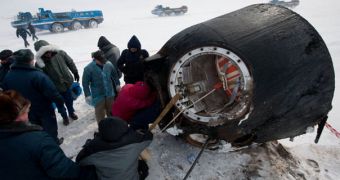With less than two months to go ahead of a planned launch into space, the second digital Soyuz space capsule is still suffering from glitches that are leaving experts puzzled. Russian engineers are currently trying to get to the bottom of things, in order to ensure a smooth mission.
The second-ever digital Soyuz is currently scheduled to fly to the International Space Station (ISS) on Mary 30, carrying a crew of three astronauts. The spacecraft is called TMA-02M.
Developed for the Russian Federal Space Agency (RosCosmos), the new spacecraft is a new and improved version of the older Soyuz design, which has served both the Soviet Union and the Russian Federation well since its introduction into active service, decades ago.
Experts first figured out that the digital Soyuz had a problem when the first capsule of the series, TMA-01M, returned home from orbit this March. The nature of the glitches discovered in its computers still elude researchers, in spite of their best efforts.
TMA-01M launched to the ISS in October 2010. During the flight to orbit, its Neptune computer console experienced a display glitch that required intervention once the spacecraft was safely docked on the orbital facility, Space reports.
The deputy head of RosCosmos, Vitaly Davidov, said that experts will analyze the capsule in more detail once it returns, but thus far no clear progress has been made.
“We have backup equipment installed onboard our vehicle [TMA-02M], this device that already was checked by the expedition that recently returned from space and we have already installed this equipment,” said Sergei Volkov during a press conference held on March 21.
The Russian cosmonaut is one of the three members of the new digital Soyuz mission, alongside Japanese astronaut Satoshi Furukawa and NASA astronaut Mike Fossum.
The main issue with this flight – as opposed to the first one – is that it will use all the capabilities and systems installed on TMA-02M, whereas the first mission did not do so. Therefore, there is a larger potential for errors occurring during this mission.
“For us it is going to be the middle of the autonomous flight to station when we’ll use almost 100 percent all abilities of new [digital control system] for the docking,” Volkov told the media.
“It is going to be really new because previous Soyuz used only partially all these abilities,” he added.
In the mean time, RosCosmos is gearing up for today's planned launch of the non-digital Soyuz TMA-21 mission, which carried three astronauts to the ISS as well. Russian cosmonauts Alexander Samokutyaev and Andrey Borisenko, and NASA astronaut Ron Gara, will remain in space for six months.

 14 DAY TRIAL //
14 DAY TRIAL //